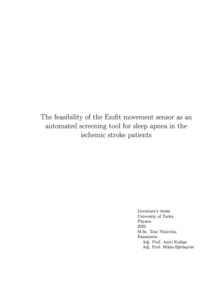The feasibility of the Emfit movement sensor as an automated screening tool for sleep apnea in the ischemic stroke patients
Niiniviita, Toni (2022-05-13)
The feasibility of the Emfit movement sensor as an automated screening tool for sleep apnea in the ischemic stroke patients
Niiniviita, Toni
(13.05.2022)
Turun yliopisto
Julkaisun pysyvä osoite on:
https://urn.fi/URN:NBN:fi-fe2022051335149
https://urn.fi/URN:NBN:fi-fe2022051335149
Tiivistelmä
Stroke is a common cause of death and a major reason for disability. Stroke survivors can have very difficult symptoms and require very intensive and expensive rehabilitation. Sleep disordered breathing, sleep apnea, is common among stroke patients, it's a high risk factor for recurrent stroke and untreated sleep apnea has a negative influence on the stroke recovery.
All stroke patients are recommended to be measured for sleep apnea, but the lack of resources don't allow it. Therefore there is a need for a screening tool to find the stroke patients who need the measurement most and who benefit the most of the treatment of the sleep apnea.
We studied the possibility to use the Emfit movement sensor combined with a pulse oximeter as a screening tool. The Emfit movement sensor doesn't have connections to the patient, therefore it wouldn't require lots of resources to set up the measurement and there are no contacts that can cause interference during the measurement. The automatic scoring of the measurement would remove the need for an expert to manually score every measurement.
The test subjects were measured at the same night using both the Emfit movement sensor and a conventional respiratory polygraphy device. The Emfit movement sensor and the standard respiratory polygraphy measurements were scored using Noxturnal's automatic analysis tool and the results were compared. The results were also compared to the manual scoring of the standard respiratory polygraphy.
The Emfit movement sensor measurement slightly overestimates the apnea hypopnea index, as does the automatically scored standard respiratory polygraphy too. The automatic analysis ability to detect correctly the duration and timing of a respiratory event in the Emfit movement sensor measurement seems to depend on the amount of noise in the measurement. Our study indicates that the Emfit movement sensor has potential to be used as a screening tool for sleep apnea in the ischemic stroke patients, but the automatic analysis still needs improvements to provide more accurate results.
All stroke patients are recommended to be measured for sleep apnea, but the lack of resources don't allow it. Therefore there is a need for a screening tool to find the stroke patients who need the measurement most and who benefit the most of the treatment of the sleep apnea.
We studied the possibility to use the Emfit movement sensor combined with a pulse oximeter as a screening tool. The Emfit movement sensor doesn't have connections to the patient, therefore it wouldn't require lots of resources to set up the measurement and there are no contacts that can cause interference during the measurement. The automatic scoring of the measurement would remove the need for an expert to manually score every measurement.
The test subjects were measured at the same night using both the Emfit movement sensor and a conventional respiratory polygraphy device. The Emfit movement sensor and the standard respiratory polygraphy measurements were scored using Noxturnal's automatic analysis tool and the results were compared. The results were also compared to the manual scoring of the standard respiratory polygraphy.
The Emfit movement sensor measurement slightly overestimates the apnea hypopnea index, as does the automatically scored standard respiratory polygraphy too. The automatic analysis ability to detect correctly the duration and timing of a respiratory event in the Emfit movement sensor measurement seems to depend on the amount of noise in the measurement. Our study indicates that the Emfit movement sensor has potential to be used as a screening tool for sleep apnea in the ischemic stroke patients, but the automatic analysis still needs improvements to provide more accurate results.
